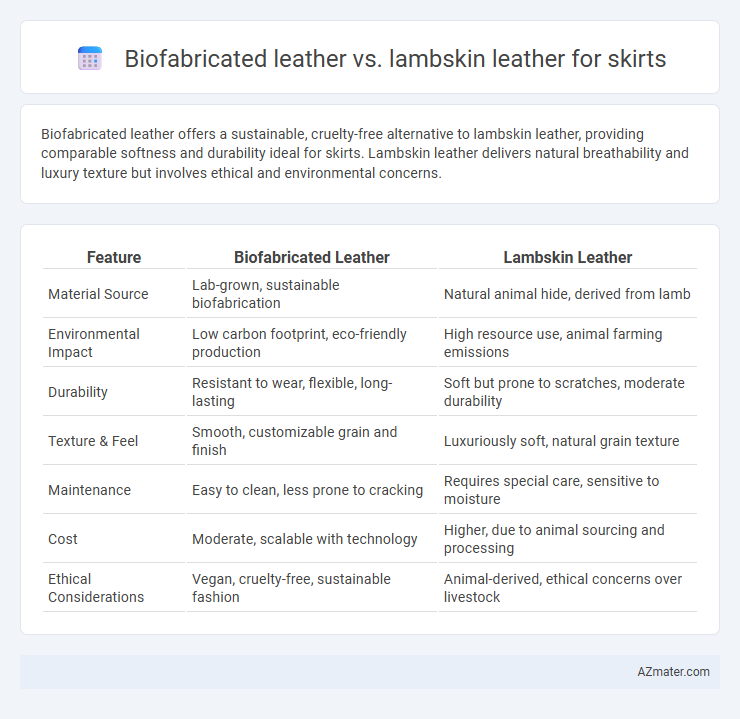Biofabricated leather offers a sustainable, cruelty-free alternative to lambskin leather, providing comparable softness and durability ideal for skirts. Lambskin leather delivers natural breathability and luxury texture but involves ethical and environmental concerns.
Table of Comparison
| Feature | Biofabricated Leather | Lambskin Leather |
|---|---|---|
| Material Source | Lab-grown, sustainable biofabrication | Natural animal hide, derived from lamb |
| Environmental Impact | Low carbon footprint, eco-friendly production | High resource use, animal farming emissions |
| Durability | Resistant to wear, flexible, long-lasting | Soft but prone to scratches, moderate durability |
| Texture & Feel | Smooth, customizable grain and finish | Luxuriously soft, natural grain texture |
| Maintenance | Easy to clean, less prone to cracking | Requires special care, sensitive to moisture |
| Cost | Moderate, scalable with technology | Higher, due to animal sourcing and processing |
| Ethical Considerations | Vegan, cruelty-free, sustainable fashion | Animal-derived, ethical concerns over livestock |
Introduction: Biofabricated Leather vs Lambskin Leather
Biofabricated leather offers an innovative, sustainable alternative to traditional lambskin leather by utilizing lab-grown materials that replicate the texture and durability of animal leather without environmental harm. Lambskin leather, prized for its softness and natural grain, remains a luxurious choice but involves ethical concerns and resource-intensive production. Comparing the two for skirt fabrication highlights a shift toward eco-conscious fashion without sacrificing style or quality.
Material Origins and Production Processes
Biofabricated leather is created through a sustainable process using cultured cells or plant-based materials, eliminating the need for animal hides and significantly reducing environmental impact. Lambskin leather, derived from the hides of young sheep, undergoes traditional tanning and finishing processes that involve chemical treatments and substantial water usage. The production of biofabricated leather focuses on innovation and eco-friendly practices, whereas lambskin leather relies on animal farming and resource-intensive manufacturing.
Environmental Impact Comparison
Biofabricated leather for skirts offers a significantly lower environmental impact compared to lambskin leather, as it requires less water, land, and energy during production while eliminating animal agriculture's greenhouse gas emissions. Lambskin leather production contributes to deforestation, methane emissions from livestock, and chemical-intensive tanning processes harmful to ecosystems. Choosing biofabricated leather reduces carbon footprint and pollution, supporting sustainable fashion initiatives aimed at minimizing ecological damage.
Texture, Feel, and Aesthetics
Biofabricated leather offers a smooth, consistent texture with a flexible yet durable feel, mimicking natural skin without the irregularities found in lambskin. Lambskin leather is prized for its ultra-soft, supple quality, providing a luxurious feel and a rich, natural grain that adds depth and character to skirts. Aesthetically, biofabricated leather presents a sleek, modern look with customizable finishes, while lambskin delivers timeless elegance and a warm, organic appearance that ages beautifully.
Durability and Longevity
Biofabricated leather offers enhanced durability compared to lambskin leather, resisting wear and tear more effectively due to its engineered material properties. Lambskin leather, known for its softness and luxury, tends to be more susceptible to scratches and stretching, which can reduce its longevity when used in skirts. For long-lasting skirts, biofabricated leather provides a resilient alternative that maintains its structural integrity over time without compromising style.
Comfort and Wearability in Skirts
Biofabricated leather offers superior breathability and flexibility compared to traditional lambskin leather, enhancing comfort for skirt wearers in varying temperatures. Lambskin leather provides a soft, natural texture that molds to the body over time, offering personalized wearability but may cause discomfort in warmer weather due to limited ventilation. Skirts made from biofabricated leather deliver consistent comfort and are often lighter, making them ideal for all-day wear without compromising style.
Ethical Considerations
Biofabricated leather offers a cruelty-free alternative to traditional lambskin leather by eliminating the need for animal slaughter, thereby addressing significant ethical concerns in fashion. This innovative material reduces animal suffering and aligns with growing consumer demand for sustainable and humane products. Ethical considerations favor biofabricated leather due to its potential to minimize environmental impact and support animal welfare without compromising quality or style in skirts.
Cost and Accessibility
Biofabricated leather for skirts offers a cost-effective alternative to traditional lambskin leather, with production costs gradually decreasing due to advancements in biotechnology and scalable manufacturing processes. Lambskin leather remains expensive and less accessible, largely due to ethical concerns, animal farming costs, and supply chain limitations. Biofabricated leather's increasing accessibility through synthetic biology innovations positions it as a sustainable, affordable option for fashion brands focusing on ethical materials.
Style Versatility and Customization
Biofabricated leather offers superior style versatility for skirts due to its adaptable texture and color options, allowing designers to create unique, trend-forward looks that mimic or surpass traditional leather aesthetics. Lambskin leather provides a classic, luxurious appearance with a soft, natural grain that enhances the elegance of skirts but limits customization to available tanning and finishing techniques. The ability to customize biofabricated leather according to specific thickness, finish, and pattern requirements makes it a preferred choice for innovative and personalized skirt designs.
Consumer Preferences and Market Trends
Biofabricated leather appeals to environmentally conscious consumers seeking cruelty-free and sustainable fashion alternatives, showing rapid growth in the skirt market segment. Lambskin leather remains favored for its unmatched softness, durability, and luxury appeal, particularly among traditional luxury shoppers. Market trends reveal increasing demand for biofabricated leather skirts driven by regulatory pressures and consumer awareness, while lambskin maintains a stable yet niche presence in premium fashion categories.

Infographic: Biofabricated leather vs Lambskin leather for Skirt
 azmater.com
azmater.com